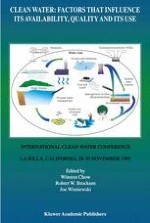1996 | OriginalPaper | Buchkapitel
Toxicity Reduction of Ontario Hydro Radioactive Liquid Waste
verfasst von : D. W. Rodgers, D. W. Evans, L. Vereecken Sheehan
Erschienen in: Clean Water: Factors that Influence Its Availability, Quality and Its Use
Verlag: Springer Netherlands
Enthalten in: Professional Book Archive
Aktivieren Sie unsere intelligente Suche, um passende Fachinhalte oder Patente zu finden.
Wählen Sie Textabschnitte aus um mit Künstlicher Intelligenz passenden Patente zu finden. powered by
Markieren Sie Textabschnitte, um KI-gestützt weitere passende Inhalte zu finden. powered by
The radioactive liquid waste (RLW) system in Ontario Hydro’s pressurised heavy water reactors collects drainage from a variety of sources ranging from floor drains to laundry waste. RLW effluent was intermittently toxic to rainbow trout and Daphnia magna during the first phase of Ontario’s Municipal Industrial Strategy for Abatement (MISA) Program, apparently as a result of the interaction of a variety of known and unknown organic and inorganic compounds. Accordingly, we employed a treatment-based approach to reducing its toxicity, supplemented by chemical analysis. Two series of toxicity reduction tests were conducted. The first series explored the potential for sorption of the possible toxicants, while the second series incorporated a wider variety of treatments. Of the 24 samples in the first test series, 17 were toxic (D. magna mortality ≥ 50%). Of the toxic samples, only 7 of 17 were still toxic after passage through an activated carbon column, but 5 of 6 samples tested remained toxic after passage through a metal chelating resin column. In the second series, at least one of the treatments was effective in reducing toxicity of all samples which were initially toxic (16 of 24 samples), but no one treatment was effective for all toxic samples. Three treatments (UV/H2O2 photo-oxidation with prior pH adjustment, or passage through a column of either a non-functionalized (N-F) resin or a mixture of N-F resin and a weak base (W-B) anion exchange resin), were effective in reducing the toxicity of more than 50% of the toxic samples; yet roughly 25% of these samples remained toxic after treatment O2 sparging, UV/H2O2 photo-oxidation without prior pH adjustment, and passage through a column of the W-B Resin were less effective, as more than 50% of the samples remained toxic after treatment. Filtering was not effective, as all of the treated samples (9/9) retained their toxicity. There was no obvious correspondence between toxicity and the concentrations of metals (Cu, Zn, Fe, A1 and Cd) nor were any simple relationships apparent between toxicity and Total Organic Carbon or NH3 concentrations. At stations where radioactive liquid wastes are segregated, toxicity was also segregated, suggesting that we may be able to address the problem at source through a combination of Best Management Practices and smaller scale treatment facilities.
